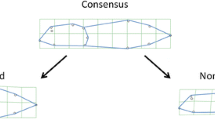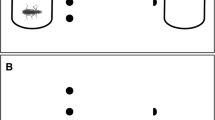Abstract
An organism’s investment in different traits to reduce predation is determined by the fitness benefit of the defense relative to the fitness costs associated with the allocation of time and resources to the defense. Inherent tradeoffs in time and resource allocation should result in differential investment in defense along a resource gradient, but competing models predict different patterns of investment. There are currently insufficient empirical data on changes in investment in defensive traits or their costs along resource gradients to differentiate between the competing allocation models. In this study, I exposed tadpoles to caged predators along a resource gradient in order to estimate investment in defense and costs of defense by assessing predator-induced plasticity. Induced defenses included increased tail depth, reduced feeding, and reduced swimming activity; costs associated with these defenses were reduced developmental rate, reduced growth, and reduced survival. At low resource availability, these costs predominately resulted in reduced survival, while at high resource availability the costs yielded a reduced developmental rate. Defensive traits responded strongly to predation risk, but did not respond to resource availability (with the exception of feeding activity), whereas traits construed as costs of defenses showed the opposite pattern. Therefore, defensive traits were highly sensitive to predation risk, while traits construed as costs of defense were highly sensitive to resource allocation tradeoffs. This difference in sensitivity between the two groups of traits may explain why the correlation between the expression of defensive traits and the expression of the associated defense costs was weak. Furthermore, my results indicate that genetic linkages and mechanistic integration of multiple defensive traits and their associated costs may constrain time and resource allocation in ways that are not addressed in existing models.

Similar content being viewed by others
References
Agrawal AA, Conner JK, Johnson MTJ, Wallsgrove R (2002) Ecological genetics of an induced plant defense against herbivores: additive genetic variance and costs of phenotypic plasticity. Evolution 56:2206–2213
Altwegg R, Reyer HU (2003) Patterns of natural selection on size at metamorphosis in water frogs. Evolution 57:872–882
Angilletta MJ, Wilson RS, Navas CA, James RS (2003) Tradeoffs and the evolution of thermal reaction norms. Trends Ecol Evol 18:234–240
Anholt BR, Werner EE (1995) Interaction between food availability and predation mortality mediated by adaptive-behavior. Ecology 76:2230–2234
Anholt BR, Werner E, Skelly DK (2000) Effect of food and predators on the activity of four larval ranid frogs. Ecology 81:3509–3521
Arendt JD (1997) Adaptive intrinsic growth rates: an integration across taxa. Q Rev Biol 72:149–177
Barry MJ (1995) The role of nutrition in regulation of predator-induced crests of Daphnia carinata. Freshw Biol 34:229–239
Benard MF (2004) Predator-induced phenotypic plasticity in organisms with complex life histories. Annu Rev Ecol Evol Syst 35:651–673
Bookstein FL (1991) Morphometric tools for landmark data: geometry and biology. Cambridge University Press, Cambridge, UK
Burnham KP, Anderson DR (2002) Model selection and multimodel inference: a practical information-theoretic approach. Springer, Berlin Heidelberg New York
Darlington RB, Smulders TV (2001) Problems with residual analysis. Anim Behav 62:599–602
DeWitt TJ, Sih A, Hucko JA (1999) Trait compensation and cospecialization in a freshwater snail: size, shape and antipredator behaviour. Anim Behav 58:397–407
Freckleton R (2002) On the misuse of residuals in ecology: regression of residuals vs. multiple regression. J Anim Ecol 71:722–722
Garcia-Berthou E (2001) On the misuse of residuals in ecology: testing regression residuals vs. the analysis of covariance. J Anim Ecol 70:708–711
Gomulkiewicz R, Kirkpatrick M (1992) Quantitative genetics and the evolution of reaction norms. Evolution 46:390–411
Gosner KL (1960) A simplified table for staging anuran embryos and larvae with notes on identification. Herpetologica 16:183–190
Harvell CD (1990) The ecology and evolution of inducible defenses. Q Rev Biol 65:323–340
Herms DA, Mattson WJ (1992) The dilemma of plants—to grow or defend. Q Rev Biol 67:283–335
Hoverman JT, Auld JR, Relyea RA (2005) Putting prey back together again: integrating predator-induced behavior, morphology, and life history. Oecologia 144:481–491
Karban R, Baldwin IT (1997) Induced responses to herbivory. University of Chicago Press, Chicago, IL
Kishida O, Nishimura K (2004) Bulgy tadpoles: inducible defense morph. Oecologia 140:414–421
LaFiandra EM, Babbitt KJ (2004) Predator induced phenotypic plasticity in the pinewoods tree frog, Hyla femoralis: necessary cues and the cost of development. Oecologia 138:350–359
Laurila A, Kujasalo J (1999) Habitat duration, predation risk and phenotypic plasticity in common frog (Rana temporaria) tadpoles. J Anim Ecol 68:1123–1132
Laurila A, Kujasalo J, Ranta E (1998) Predator-induced changes in life history in two anuran tadpoles: effects of predator diet. Oikos 83:307–317
Lima SL (1998) Stress and decision making under the risk of predation: recent developments from behavioral, reproductive, and ecological perspectives. Adv Stud Behav 27:215–290
McCollum SA, Van Buskirk J (1996) Costs and benefits of a predator-induced polyphenism in the gray treefrog Hyla chrysoscelis. Evolution 50:583–593
McPeek MA (2004) The growth/predation risk trade-off: so what is the mechanism? Am Nat 163:E88–E111
Myers JH, Bazely D (1991) Thorns, spines, prickles, and hairs: are they stimulated by herbivory and do they deter herbivores? In: Tallamy DW, Raupp MJ (eds) Phytochemical induction by herbivores. Wiley, New York, pp 325–344
Peacor SD (2002) Positive effect of predators on prey growth rate through induced modifications of prey behaviour. Ecol Lett 5:77–85
Peacor SD (2003) Phenotypic modifications to conspecific density arising from predation risk assessment. Oikos 100:409–415
Relyea RA (2002) Costs of phenotypic plasticity. Am Nat 159:272–282
Relyea RA (2004) Fine-tuned phenotypes: tadpole plasticity under 16 combinations of predators and competitors. Ecology 85:172–179
Riis N (1991) A field study of survival, growth biomass and temperature dependence of Rana dalmatina and Rana temporaria larvae. Amphib Reptil 12:229–243
Skelly DK (1992) Field evidence for a cost of behavioral antipredator response in a larval amphibian. Ecology 73:704–708
Skelly DK, Werner EE (1990) Behavioral and life-historical responses of larval American toads to an odonate predator. Ecology 71:2313–2322
Stearns SC (1992) The evolution of life-histories. Oxford University Press, Oxford
Steiner UK (2005) Cost of predator-induced plasticity and cost of responding to predators in tadpoles. Ph.D. Thesis. Universität Zürich, Switzerland
Steiner UK, Pfeiffer T (2007) Optimizing time and resource allocation trade-offs for investment into morphological and behavioral defense. Am Nat 169:118–129
Teplitsky C, Plenet S, Joly P (2005) Costs and limits of dosage response to predation risk: to what extent can tadpoles invest in anti-predator morphology? Oecologia 145:364–370
Tollrian R, Harvell CD (1992) The ecology and evolution of inducible defenses. Princeton University Press, Princeton, NJ
Tuomi J, Fagerstrom T, Niemela P (1991) Carbon allocation, phenotypic plasticity, and induced defenses. In: Tallamy DW, Raupp MJ (eds) Phytochemical induction by herbivores. Wiley, New York, pp 85–104
Van Buskirk J (2000) The costs of an inducible defense in anuran larvae. Ecology 81:2813–2821
Van Buskirk J (2002) A comparative test of the adaptive plasticity hypothesis: relationships between habitat and phenotype in anuran larvae. Am Nat 160:87–102
Van Buskirk J (2005) Local and landscape influence on amphibian occurrence and abundance. Ecology 86:1936–1947
Van Buskirk J, Arioli M (2002) Dosage response of an induced defense: how sensitive are tadpoles to predation risk? Ecology 83:1580–1585
Van Buskirk J, Arioli M (2005) Habitat specialization and adaptive phenotypic divergence of anuran populations. J Evol Biol 18:596–608
Van Buskirk J, McCollum SA (2000) Functional mechanisms of an inducible defence in tadpoles: morphology and behaviour influence mortality risk from predation. J Evol Biol 13:336–347
Van Buskirk J, Yurewicz KL (1998) Effects of predators on prey growth rate: relative contributions of thinning and reduced activity. Oikos 82:20–28
Werner EE, Anholt BR (1993) Ecological consequences of the trade-off between growth and mortality-rates mediated by foraging activity. Am Nat 142:242–272
Werner EE, Anholt BR (1996) Predator-induced behavioral indirect effects: consequences to competitive interactions in anuran larvae. Ecology 77:157–169
Yearsley J, Hastings IM, Gordon IJ, Kyriazakis I, Illius AW (2002) A lifetime perspective on foraging and mortality. J Theor Biol 215:385–397
Acknowledgments
Thanks to Josh Van Buskirk, Karim Al-Khafaji, Simone Härri, Heinz-Ulrich Reyer, Annette Sautter, Benedikt Schmidt, Shripad Tuljapurkar, for discussions and helpful comments on the manuscript. I am grateful to Anssi Laurila and two anonymous referees who provided comments that improved the manuscript. I also would like to thank Eva Sabiote and Bettina Niederer for their help in the field. The experiments comply with the current laws of Switzerland and were carried out under the permit 72/2003 of the Veterinäramt Zürich. I was supported by a Swiss National Science Foundation (31-64991.01) grant to Josh Van Buskirk.
Author information
Authors and Affiliations
Corresponding author
Additional information
Communicated by Anssi Laurila.
Electronic supplementary material
Below is the link to the electronic supplementary material.
Rights and permissions
About this article
Cite this article
Steiner, U.K. Investment in defense and cost of predator-induced defense along a resource gradient. Oecologia 152, 201–210 (2007). https://doi.org/10.1007/s00442-006-0645-3
Received:
Accepted:
Published:
Issue Date:
DOI: https://doi.org/10.1007/s00442-006-0645-3




